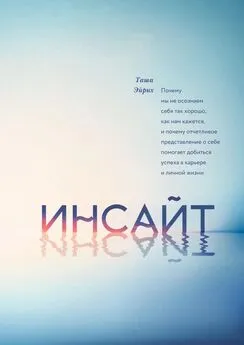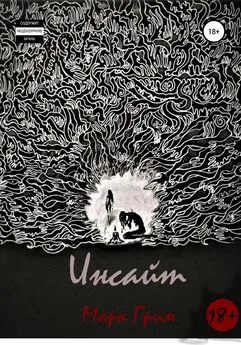Таша Эйрих - Инсайт
- Название:Инсайт
- Автор:
- Жанр:
- Издательство:Манн, Иванов и Фербер
- Год:2018
- Город:Москва
- ISBN:9785001170136
- Рейтинг:
- Избранное:Добавить в избранное
-
Отзывы:
-
Ваша оценка:
Таша Эйрих - Инсайт краткое содержание
Инсайт - читать онлайн бесплатно ознакомительный отрывок
Интервал:
Закладка:
280
Clare Ansberry. “The power of daily writing in a journal,” wsj.com, January 26, 2016, http://www.wsj.com/articles/the-power-of-daily-writing-in-a-journal-1453837329.
281
Anthony M. Grant, John Franklin, and Peter Langford. “The self-reflection and insight scale: A new measure of private self-consciousness.” Social Behavior and Personality: An International Journal 30.8 (2002): 821–835.
282
James W Pennebaker. “Writing about emotional experiences as a therapeutic process.” Psychological Science 8.3 (1997): 162–166.
283
Brian A. Esterling, et al. “Empirical foundations for writing in prevention and psychotherapy: Mental and physical health outcomes.” Clinical Psychology Review 19.1 (1999): 79–96.
284
James W. Pennebaker, Janice K. KiecoltGlaser, and Ronald Glaser. “Disclosure of traumas and immune function: health implications for psychotherapy.” Journal of Consulting and Clinical Psychology 56.2 (1988): 239–245.
285
Crystal L. Park and Carol Joyce Blumberg. “Disclosing trauma through writing: Testing the meaning-making hypothesis.” Cognitive Therapy and Research 26.5 (2002): 597–616.
286
Kitty Klein and Adriel Boals. “Expressive writing can increase working memory capacity.” Journal of Experimental Psychology: General 130.3 (2001): 520–533.
287
James W. Pennebaker and Martha E. Francis. “Cognitive, emotional, and language processes in disclosure.” Cognition & Emotion 10.6 (1996): 601–626.
288
Martha E. Francis and James W. Pennebaker. “Putting stress into words: The impact of writing on physiological, absentee, and self-reported emotional well-being measures.” American Journal of Health Promotion 6.4 (1992): 280–287.
289
Stefanie P. Spera, Eric D. Buhrfeind, and James W. Pennebaker. “Expressive writing and coping with job loss.” Academy of Management Journal 37.3 (1994): 72-733.
290
V. B. Scott, et al. “Emotive writing moderates the relationship between mood awareness and athletic performance in collegiate tennis players.” North American Journal of Psychology 5.2 (2003): 311–324.
291
James W. Pennebaker, Janice K. KiecoltGlaser, and Ronald Glaser. “Disclosure of traumas and immune function: health implications for psychotherapy.” Journal of Consulting and Clinical Psychology 56.2 (1988): 239–245.
292
114 showed less personal growth: Sonja Lyubomirsky, Lorie Sousa, and Rene Dickerhoof. “The costs and benefits of writing, talking, and thinking about life’s triumphs and defeats.” Journal of Personality and Social Psychology 90.4 (2006): 692–708.
293
G. K. Chesterton. Heretics. Butler and Tanner, 1905, p. 103. (Честертон Г. Еретики. М.: Амфора, 2008.
294
Bridget Murray. “Writing to heal,” apa.org, June 2002, http://www.apa.org/monitor/jun02/writing.aspx.
295
Clare Ansberry. “The power of daily writing in a journal,” wsj.com, January 26, 2016, http://www.wsj.com/articles/the-power-of-daily-writing-in-a-journal-1453837329.
296
Если при осмыслении негативных событий автор употребляет каузальные, связанные с инсайтом слова, такие как «делать выводы», «рассуждать логически», «понимать» и «осознавать», ведение дневника начинает приносить гораздо больше пользы. James W. Pennebaker. “Writing about emotional experiences as a therapeutic process.” Psychological Science 8.3 (1997): 162–66; James W. Pennebaker, Tracy J. Mayne, and Martha E. Francis. “Linguistic predictors of adaptive bereavement.” Journal of Personality and Social Psychology 72.4 (1997): 863–871.
297
James W. Pennebaker and Sandra K. Beall. “Confronting a traumatic event: Toward an understanding of inhibition and disease.” Journal of Abnormal Psychology 95.3 (1986): 274–281.
298
Christopher D. B. Burt. “An analysis of a self-initiated coping behavior: Diary-keeping.” Child Study Journal 24.3 (1994): 171–189.
299
James W. Pennebaker. “Writing about emotional experiences as a therapeutic process.” Psychological Science 8.3 (1997): 162–166.
300
Jordan Gaines Lewis, Ph.D. “Turning Trauma into Story: The Benefts of Journaling,” psychologytoday.com, August 17, 2012, https://www.psychologytoday.com/blog/brain-babble/201208/turning-trauma-story-the-benefts-journaling.
301
По мнению большинства исследователей, руминация отличается от беспокойства: руминация сосредоточена главным образом на событиях прошлого и настоящего, а беспокойство — на страхах по поводу будущего.
302
В момент рефлексии мозг работает в пассивном режиме. Недавно профессор Стэнфордского университета Дж. Пол Гамильтон обнаружил, что при руминации активируется та область головного мозга, которая, помимо всего прочего, отвечает за восприятие чувства печали — субгенуальная область префронтальной коры. Тот факт, что во время руминации активируются эти две области головного мозга, помогает объяснить, почему руминация часто маскируется под самонаблюдение, а также как она блокирует способность нашего мозга обрести инсайт. J. Paul Hamilton et al. “Depressive rumination, the default-mode network, and the dark matter of clinical neuroscience.” Biological Psychiatry 78.4 (2015): 224–230. Хотя это достаточно громоздкая формулировка, почувствовав, что вы зациклились на какой-то мысли, скажите себе: «Моя субгенуальная префронтальная кора снова выводит меня из равновесия и мешает мне обрести инсайт!».
303
T. Pyszczynski and J. Greenberg. “Self-regulatory perseveration and the depressive self-focusing style: A self-awareness theory of reactive depression.” Psychological Bulletin 102.1 (1987): 122–138. См. также Ann G. Phillips and Paul J. Silvia. “Self-awareness and the emotional consequences of self-discrepancies.” Personality and Social Psychology Bulletin 31.5 (2005): 703–713.
304
V. B. Scott and William D. McIntosh. “The development of a trait measure of ruminative thought.” Personality and Individual Differences 26.6 (1999): 1045–1056.
305
Sonja Lyubomirsky, et al. “Why ruminators are poor problem solvers: clues from the phenomenology of dysphoric rumination.” Journal of Personality and Social Psychology 77.5 (1999): 1041–1060.
306
Nilly Mor and Jennifer Winquist. “Self-focused attention and negative affect: a meta-analysis.” Psychological Bulletin 128.4 (2002): 638–662.
307
Jacob A. Nota and Meredith E. Coles. “Duration and timing of sleep are associated with repetitive negative thinking.” Cognitive Therapy and Research 39 (2015): 253–261.
308
T. Pyszczynski and J. Greenberg. “Self-regulatory perseveration and the depressive self-focusing style: A self-awareness theory of reactive depression.” Psychological Bulletin 102.1 (1987): 122–138.
309
Peter Kinderman, et al. “Psychological processes mediate the impact of familial risk, social circumstances and life events on mental health.” PLOS One 8.10 (2013): e76564.
310
Joseph Ciarrochi and Greg Scott. “The link between emotional competence and well-being: A longitudinal study.” British Journal of Guidance & Counselling 34.2 (2006): 231–243.
311
Rick Harrington and Donald A. Loffredo. “Insight, rumination, and self-reflection as predictors of well-being.” Journal of Psychology 145.1 (2010): 39–57.
312
Steven C. Hayes, et al. “Experiential avoidance and behavioral disorders: A functional dimensional approach to diagnosis and treatment.” Journal of Consulting and Clinical Psychology 64.6 (1996): 1152.
313
Rick E. Ingram. “Self-focused attention in clinical disorders: Review and a conceptual model.” Psychological Bulletin 107.2 (1990): 156–176.
314
Jay G. Hull. “A self-awareness model of the causes and effects of alcohol consumption.” Journal of Abnormal Psychology 90.6 (1981): 586–600.
315
S. Rachman, J. Grüter-Andrew, and R. Shafran. “Post-event processing in social anxiety.” Behaviour Research and Therapy 38.6 (2000): 611–617.
316
Jeffrey A. Joireman, Les Parrott III, and Joy Hammersla. “Empathy and the self-absorption paradox: Support for the distinction between self-rumination and self-reflection.” Self and Identity 1.1 (2002): 53–65.
317
Carol I. Diener and Carol S. Dweck. “An analysis of learned helplessness: Continuous changes in performance, strategy, and achievement cognitions following failure.” Journal of Personality and Social Psychology 36 (1978): 451–462; Carol I. Diener and Carol S. Dweck. “An analysis of learned helplessness: II. The processing of success.” Journal of Personality and Social Psychology 39.5 (1980): 940–952.
318
Don VandeWalle, et al. “The influence of goal orientation and self-regulation tactics on sales performance: A longitudinal field test.” Journal of Applied Psychology 84.2 (1999): 249–259.
319
Allison Abbe, Chris Tkach, and Sonja Lyubomirsky. “The art of living by dispositionally happy people.” Journal of Happiness Studies 4.4 (2003): 385–404.
320
R. S. Stern, M. S. Lipsedge, and I. M. Marks. “Obsessive ruminations: A controlled trial of thoughtstopping technique.” Behaviour Research and Therapy 11.4 (1973): 659–662.
321
Луис Ламур (1908–1988) — американский писатель, автор приключенческих романов в стиле вестерн. Прим. ред. .
322
Cara Feinberg. “The mindfulness chronicles,” harvardmagazine.com, September/October 2010, http://harvardmagazine.com/2010/09/the-mindfulness-chronicles.
Читать дальшеИнтервал:
Закладка:




![Таша Танари - Подарить душу демону [publisher: ИДДК]](/books/1073950/tasha-tanari-podarit-dushu-demonu-publisher-iddk.webp)
![Таша Танари - Испытать силу демона [publisher: ИДДК]](/books/1073951/tasha-tanari-ispytat-silu-demona-publisher-iddk.webp)




